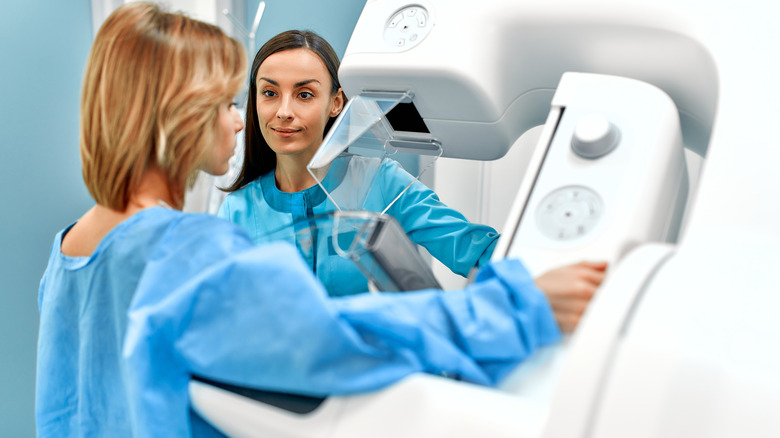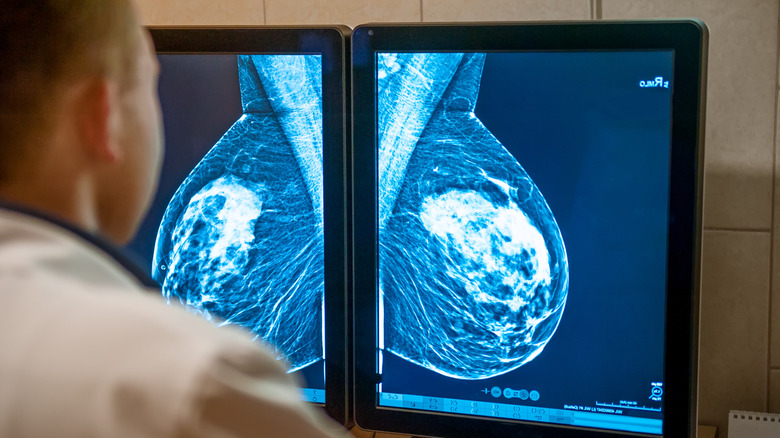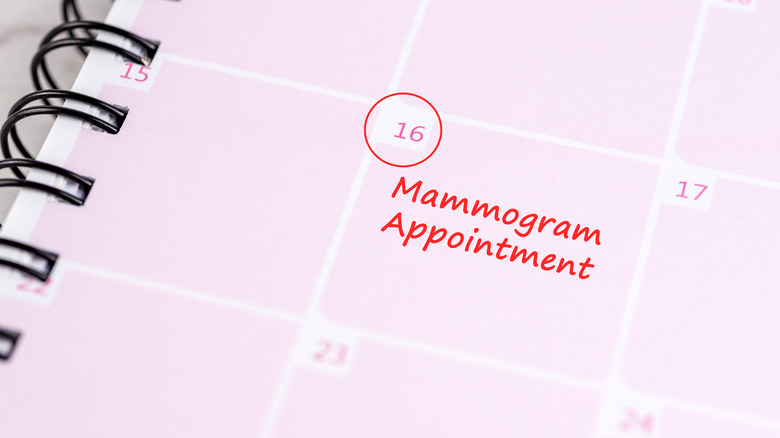How Long Does A Mammogram Take?
In the ranking of most dreaded screening exams, mammograms rank just below colonoscopies (at least mammograms don't involve a whole day of prep work that also leaves you in the bathroom for hours). The Centers for Disease Control recommend that women between 50 and 74 be screened for breast cancer every two years while women in their 40s should talk to their doctors to determine if screening is a good option for them.
Still, the thought of undergoing a mammogram is similar to how we often feel about eating our veggies: We know it's the right thing to do, but we'd rather avoid it. There's typically a lot of anxiety involved when you book a breast cancer screening. Foremost, of course, is the fear that the doctor will find something. Even though the vast majority of breast lumps are benign, no one wants to hear that there's something unusual going on.
Then there's the apprehension surrounding the mammogram itself. If you've never had one before, you might wonder if you'll be spending an eternity having your breasts shifted, squeezed, and scanned. If that particular fear is keeping you from scheduling the appointment, it may help to know that a mammogram isn't a long and drawn-out procedure. In fact, you'll probably spend just as much time changing into the flimsy paper gown as you will doing the actual exam.
A mammogram is quicker than you might think
At your mammogram appointment, you'll be asked to remove your top and bra and change into a gown that opens in the front, per The American Cancer Society. Then, you'll be brought into the screening room, where the technician will have you stand in front of the machine. One at a time, your breasts will be placed between two plastic plates; then the upper plate will be lowered onto the breast, compressing it for a clear view.
The technician will probably adjust the position of your breasts once or twice during the procedure. The entire process only takes about 10 to 20 minutes — about the length of a dental cleaning. The compression is the most dreaded part; no one wants to have their girls flattened. But it may not be as awful an experience as you think. Most women reportedly feel some pressure that's uncomfortable, but not outright agonizing.
Those with smaller breasts or a history of fibrocystic breasts may feel more discomfort than others, however. To make the procedure as painless as possible, avoid scheduling it just before or during your period when your breasts are more likely to be sensitive. Medical News Today adds that cutting back on caffeine and smoking can make your breasts feel less tender in general, too. Most of all, try to relax as much as you can.
You can help make your mammogram go smoothly
There are a few other things you can do to help make your mammogram experience easy and, crucially, accurate. Top of the list is avoiding putting anything on or around your breasts on the day of the appointment. Deodorants, body lotions, body butter, and the like can all leave residue on your breasts that might look like calcifications or cancer cells on the imaging screen. It's also important to tell the technician about any specific concerns. For instance, have you noticed any change in the appearance or feel of your breasts, such as pain, heat, a rash or dimpling of the skin, or heaviness on one side? Have you actually felt a lump during a self-exam?
Once the mammogram is complete, the results will be sent to your healthcare provider. Be sure to follow up with your doctor, if you don't hear anything, to make sure there's no need for further action. If the imaging shows any signs of abnormality, you'll be called back for further diagnostic screening. This may consist of another mammogram, an ultrasound, or an MRI, depending on the density of your breasts and the area of concern, per the American Cancer Society.
Again, most diagnostic screenings find no signs of cancer. Granted, there are much more pleasant ways to spend 20 minutes of your time than having your breasts pressed against an X-ray plate. But when it comes to your health, a mammogram is time well spent.


